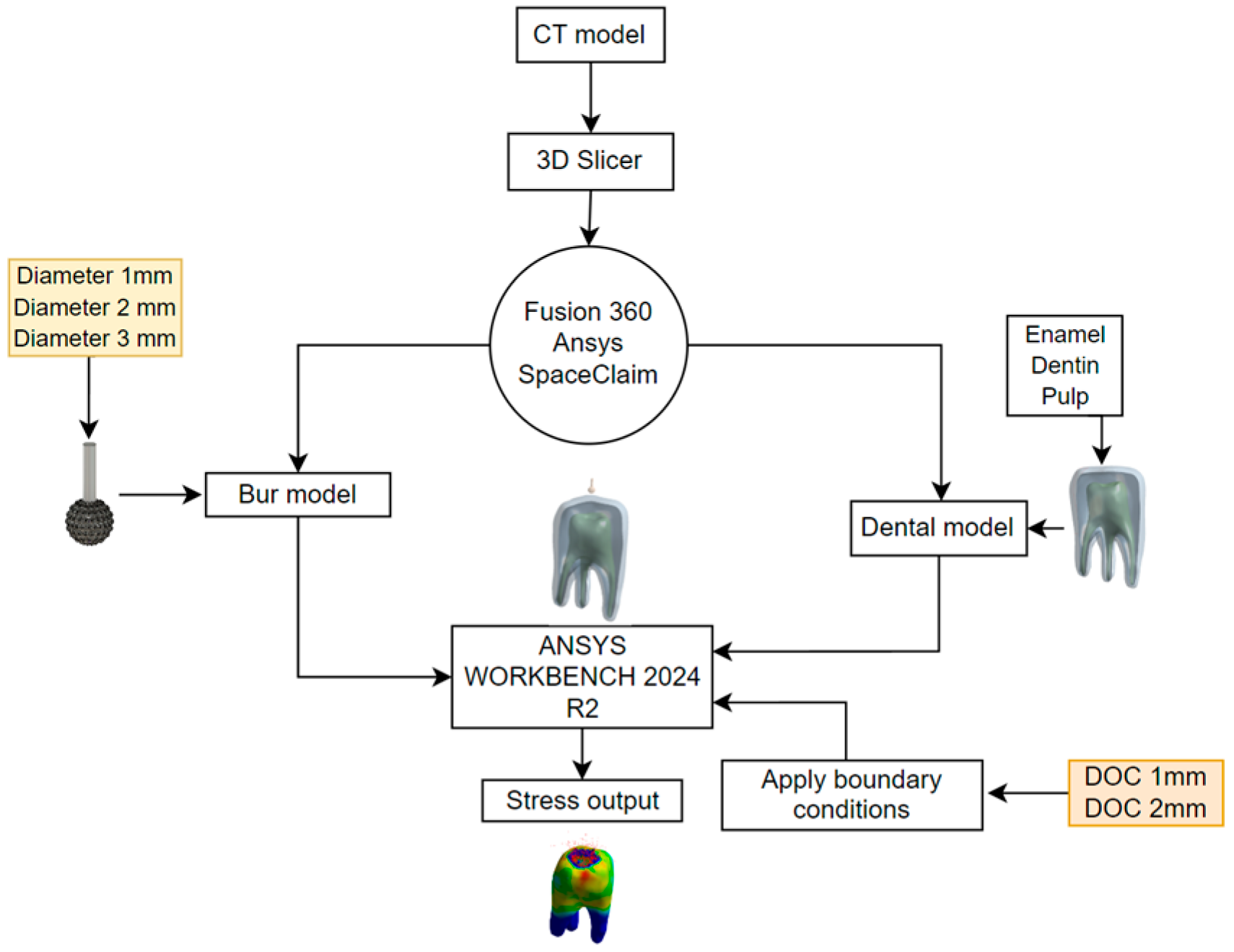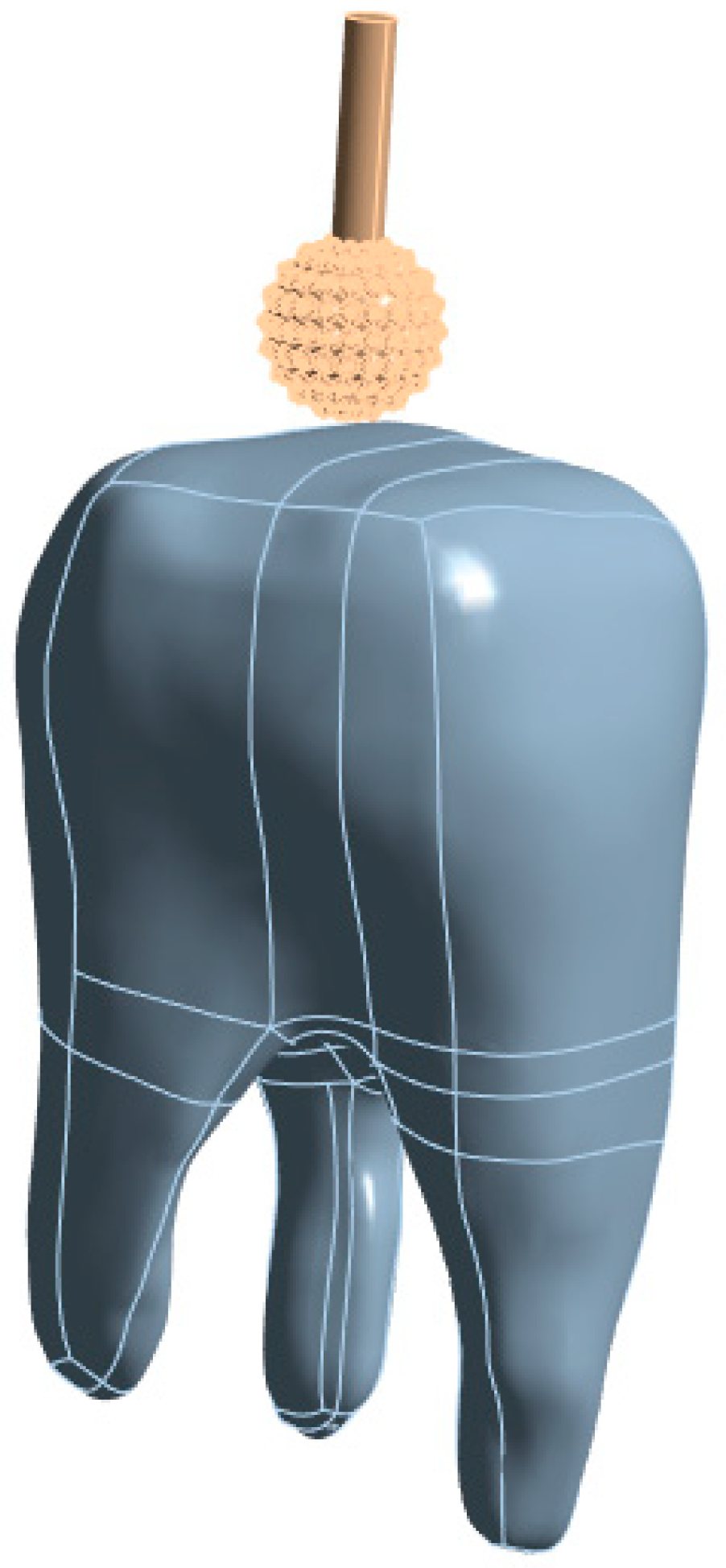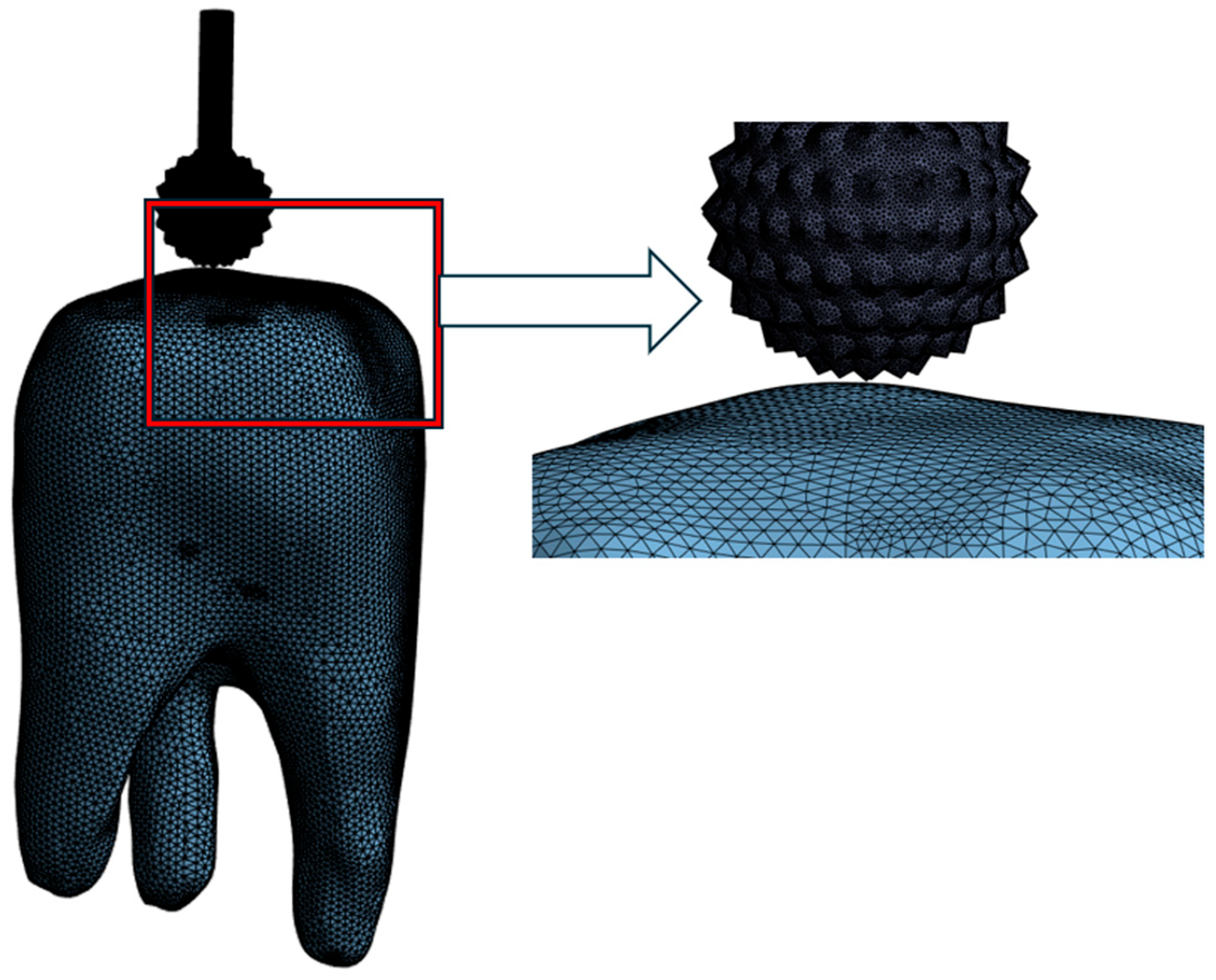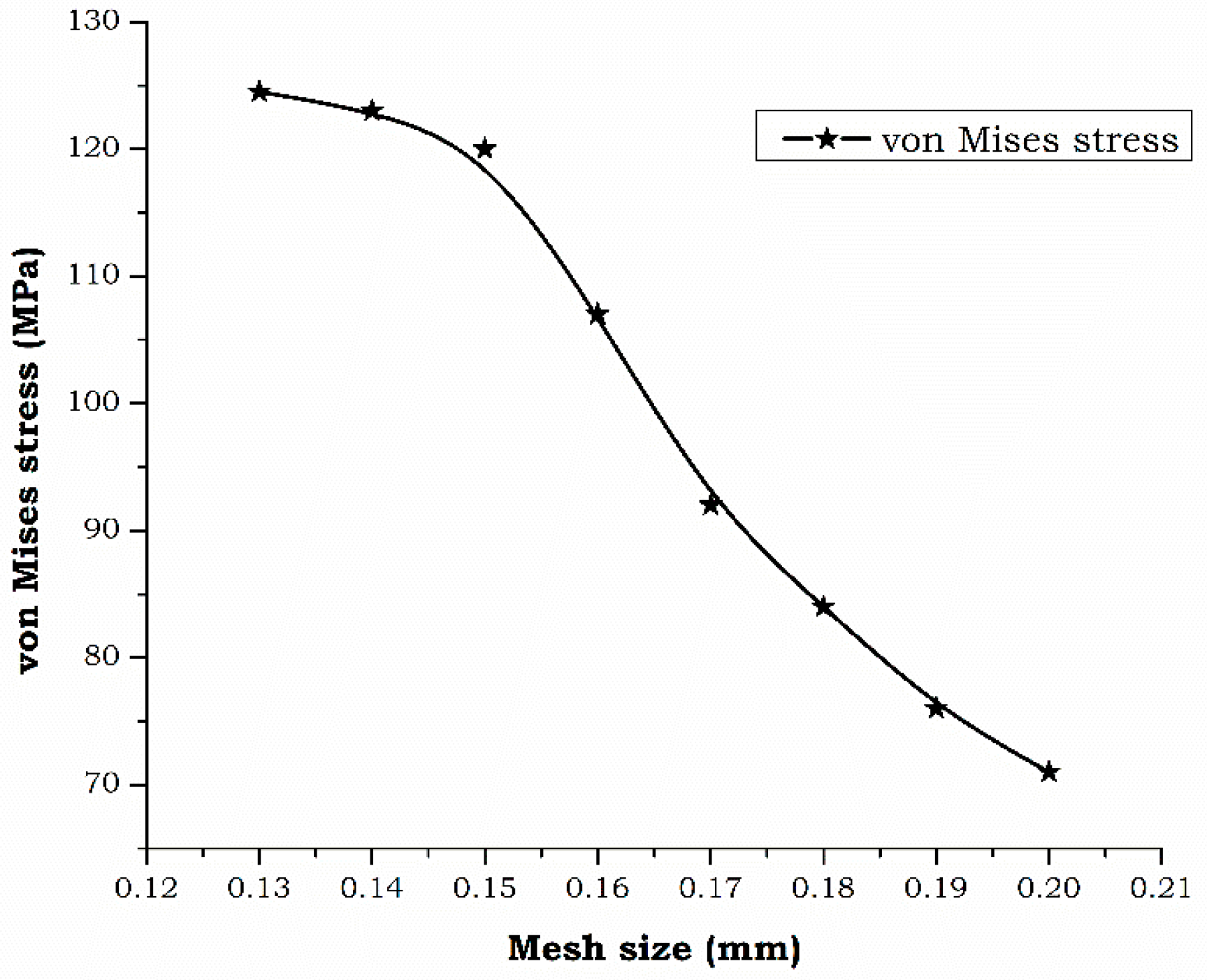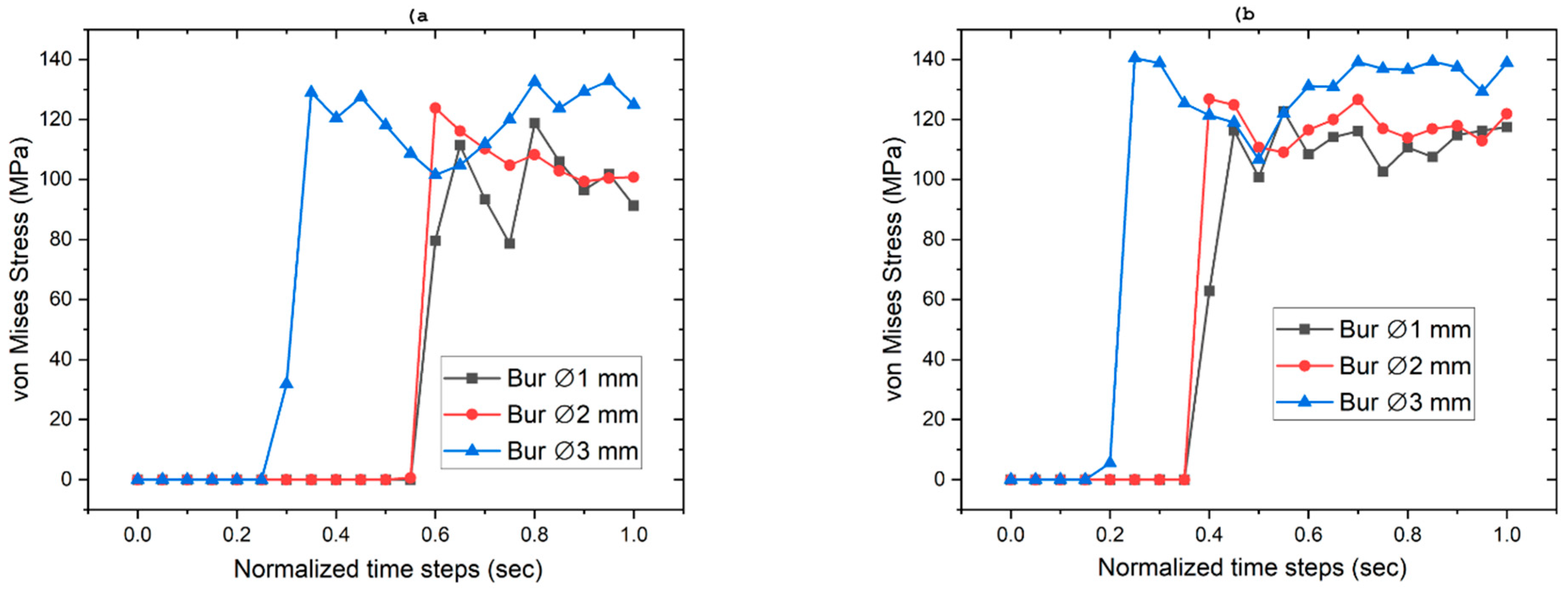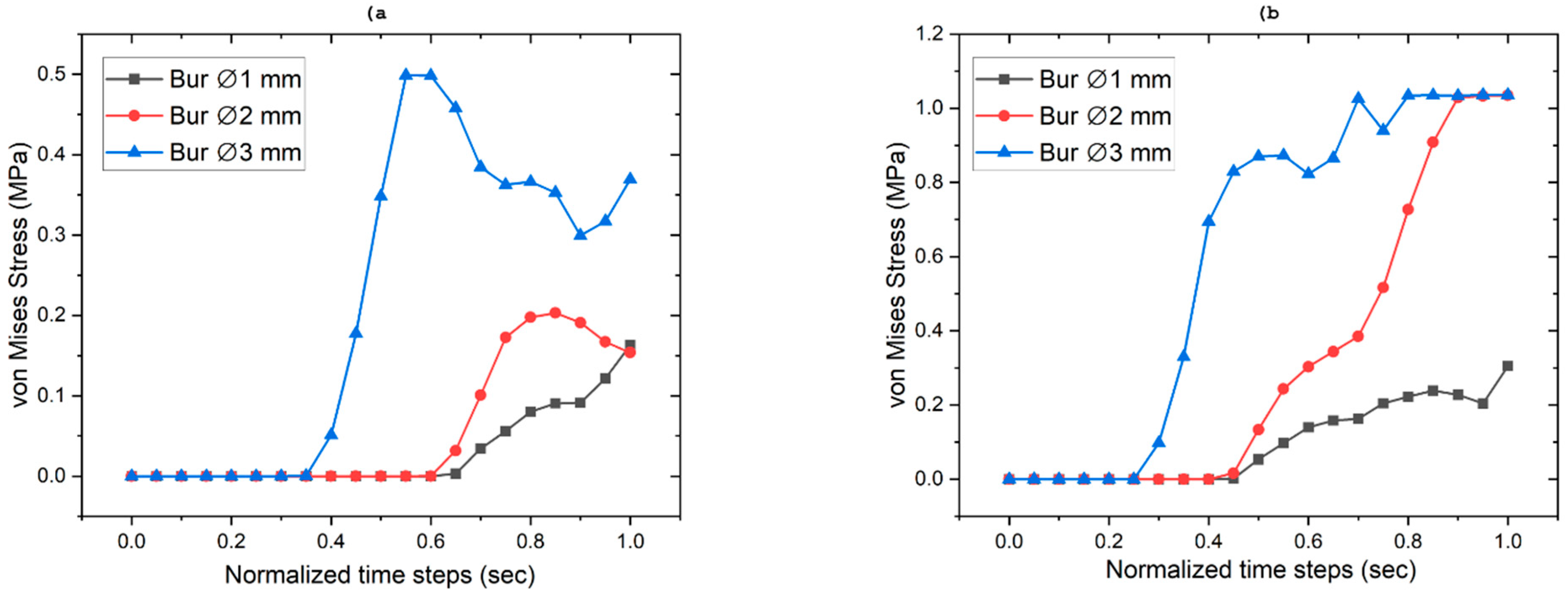1. Introduction
Dental cavity or root canal preparation is a common procedure in dental surgeries. In this procedure, the dentist prepares the teeth for better access to fillings, crowns, and veneers. The cavity shape supports long-term restoration retention, esthetic optimization, and preservation of the structural integrity of the tooth. The dental enamel is the hardest structure of the outer tooth and has unique biomechanical properties. Enamel consist mainly of hydroxyapatite crystals, forming a highly mineralized structure with exceptional hardness and brittleness [
1]. Despite its mechanical robustness, enamel is susceptible to microfractures and chipping during tooth preparation, which can compromise tooth longevity and the success of restorative treatments [
2,
3]. Dental instruments such as diamond burs are commonly used for tooth preservation because of their cutting efficiency [
4]. These instruments are bonded with abrasive particles on a metal substrate, allowing effective slicing of the enamel while minimizing heat generation and vibration during rotation. The choice of diamond bur is crucial for the clinical success of the procedure. These small rotating instruments are typically made of high-speed steel or tungsten carbide, and they come in a variety of shapes and sizes to accommodate different dental procedures. For instance, round burs are commonly employed for cavity preparation, whereas tapered fissure burs are ideal for creating precise angles in tooth structures. Factors such as grit size, rotational speed, and clinician technique significantly influence the precision and safety of enamel removal [
5]. The size of the bur is equally important. Round burs are categorized by their diameter, ranging from 0.5 mm to 4 mm. Smaller burs are typically used for intricate work, such as accessing narrow canals in endodontics, whereas larger burs are suited for large material removals. Understanding the appropriate size and type of bur can significantly affect the efficiency of the procedure and overall comfort of the patient. ISO- 806 314 001 is the most used round bur in dentistry [
6]. This is due to the versatility and efficiency of dental procedures. Modern burs often have spherical heads coated with diamond grit, which offers enhanced control and cutting performance. Despite their widespread use, the interaction between diamond burs and enamel under various loading conditions is not fully understood, and further investigation of the biomechanical response of enamel during tooth preparation is required.
Enamel machinability refers to the ease and quality with which the enamel can be cut or shaped using dental instruments. It is a critical factor influencing clinical outcomes, including the precision of cavity margins, preservation of sound tooth structure, and reduction of iatrogenic damage such as microcracks or thermal injury [
7,
8]. Optimal dental machinability ensures the minimal removal of healthy tissues during dental procedures. However, the highly mineralized and anisotropic structure of enamel presents challenges in achieving constant machinability across different zones of the tooth [
9]. Understanding enamel machinability is essential for developing optimized bur designs and clinical protocols that enhance procedural efficiency and patient safety [
10,
11]. Song et al. [
12] introduced the quantitative effect of diamond grit size on subsurface damage during dental adjustment of porcelain surfaces. Their findings revealed that coarse burs induced significantly deeper subsurface damage than fine burs, highlighting the importance of grit size in controlling the damage depth. Watson et al. [
13] compared the cutting dynamics of high-speed, high-torque handpieces and high-speed, low-torque air-turbine handpieces, focusing on enamel cracking and tooth temperature changes during cavity preparation. Their research highlighted the importance of handpiece controlling the torque to minimize potential damage to the tooth structure during dental procedures. Al-Omari et al. [
14] examined the roughness of the enamel’s surface along with its wettability, as well as the dentine surfaces that were prepared using various dental burs. The authors highlighted that smoother surfaces were more favorable for bonding procedures, emphasizing the need for appropriate bur selection to achieve optimal surface characteristics for restorative treatments. Zhao et al. [
15] investigated the cutting mechanisms and performances of different dental burs in enamel machining. Fissure, diamond, and round burs were compared during the drilling and milling experiments on various tooth surfaces. Their findings highlight the need to select burs based on their cutting performance and structural characteristics. Li et al. [
16] examined the machinability of enamel during grinding using diamond dental burs. The results indicated that occlusal surface grinding generated higher normal forces and rougher surfaces than axial surface grinding did. Fine diamond burs, lower grinding speeds, and reduced depths were found to improve surface quality by minimizing brittle failure and enhancing enamel surface smoothness.
Finite element analysis (FEA) is a computational modeling technique that is widely used in biomechanical engineering to analyze stress distribution and material deformation in complex structures. In the context of dental research, FEA is a powerful tool for simulating the mechanical interactions between the dental burs and enamel during cavity preparation. By discretizing the enamel structure into smaller elements, FEA enables a detailed study of stress patterns, strain distribution, and potential fracture initiation within the tissue [
17,
18]. Song et al. [
19] utilized FEA to investigate the stress fields and subsurface damage in ceramic prostheses during simulated intraoral dental resurfacing. This study focused on the effects of operational parameters, such as the depth of cut and chip thickness, on subsurface damage. The results revealed that tensile, shear, and compressive stress were concentrated under the diamond bur contact zone, and the subsurface damage increased with the depth of cut. Guan et al. [
20] conducted a finite element study to simulate stress distribution within the mandible during dental implant insertion. The results indicated that the stress levels in the cancellous and cortical bones were significantly lower in the thread-forming scenario. The study highlighted that greater stress occurs in the cancellous bone than in the cortical bone during insertion. The application of FEA in dental research has provided valuable contributions to understanding tooth biomechanics, such as stress distribution in restorative materials, fracture risk in endodontically treated teeth, and the load-bearing capacity of dental implants [
21,
22,
23]. However, the use of FEA to evaluate enamel machinability during tooth preparation using diamond burs remains limited. Existing studies have primarily focused on gross stress patterns without sufficient attention to the localized mechanical behavior of enamel and the influence of bur design parameters on stress propagation [
16,
20,
23]. The present study utilized ANSYS Workbench to model and analyze the explicit dynamics of diamond burs of varying diameters during cavity preparation to investigate stress distribution in dental structures. The null hypothesis (H
0) for this study was that variations in bur diameter and cutting depth do not significantly influence stress distribution in enamel, dentin, or pulp during cavity preparation. The alternative hypothesis (H
1) is that both the bur diameter and depth of cut significantly affect stress magnitudes and propagation patterns within dental tissues.
2. Materials and Methods
A three-dimensional human maxillary first molar model was generated from computed tomography (CT) scan data using a 3D Slicer software. DICOM CT images were processed to create a solid model that retained accurate anatomical features. This model was then refined using Fusion 360 and ANSYS Space Claim 2024 to smoothen surface irregularities and ensure mesh compatibility.
The dental structural components (enamel, dentin, and pulp) were segmented and modeled up to 1 mm from the occlusal surface. Diamond-coated round burs of three diameters (1 mm, 2 mm, and 3 mm) were modeled using Fusion 360 and assembled with the tooth model in ANSYS Workbench 2024 R2. These burs were considered rigid bodies in the simulation, whereas dental tissues were modeled as deformable using the Cowper–Symonds material model.
2.1. Modeling
As shown in
Figure 1, a dental model was generated using CT data acquired using a I-CAT 17-19 scanner (imaging Science international LLC, Hatfield, PA, USA). The DICOM-format images were processed using 3D Slicer software, version 5.2.2 (Brigham and Women’s Hospital, Harvard Medical School, Boston, MA, USA), an open-source medical imaging platform. The DICOM and Communications in Medicine format of the CT images was used to model the actual tooth structure. As this was a computational study based on a single anatomical model derived from CT data, randomization was not applicable. Similar simulation-based approaches have been reported without randomization [
23]. The images were processed using the 3D Slicer open-source software. The software was used for image analysis and scientific visualization. The DICOM CT images were opened in a 3D slicer, and the model was generated. The original CT-derived model included an anatomically accurate crown morphology with grooves, pits, cusps, and ridges. However, during the geometry cleaning and preparation phase, these surface details were intentionally smoothed using Fusion 360 and ANSYS SpaceClaim 2024 to facilitate the mesh quality, convergence, and solver stability in an explicit dynamic simulation environment. Highly detailed surfaces tend to produce complex, irregular element shapes that lead to excessive simulation time, non-physical stress concentrations, or convergence failure. The dental structural model, enamel, dentin, and pulp were considered at a distance of 1 mm from the top surface. The dental structure and its components are shown in
Figure 2a. As the tooth selected is the upper first molar, the tooth structures are shown as in
Figure 2b with the crown directed downwards. A diamond-coated round bur tool was modeled to analyze the cavity preparation in the tooth structure. The grit arrangement is assumed to be compatible with the simulation results. The assumed bur was modeled using Fusion 360. In the current analysis, we considered three models with diameters of 1 mm, 2 mm, and 3 mm. The modeled burs cover a wide range and are commonly used in cavity preparation and tooth cutting. Smaller burs were used for fine and precise cavity access, whereas larger burs were used for material removal and tooth shaping. In addition, these ranges allowed us to investigate stress distribution during the procedure for cutting efficiency and structural impact on dental structures.
Figure 2b shows the assumed diamond round-bur model with a defined diameter. The assembly of the bur and dental structure models is shown in
Figure 3. These models were used for simulation in ANSYS Workbench 2024 R2. The minimum distance between the burs and the teeth was maintained to avoid a longer simulation time.
2.2. Meshing and Boundary Conditions
Figure 4 shows the meshed model. Four nodded tetrahedral elements were adopted for meshing.
Table 1 presents the quantities of nodes and elements. The behavior of the bur is characterized as rigid, whereas the dental structure is regarded as deformable or flexible.
Figure 5 presents the grid independence study conducted during the simulation of the dental bur cavity access preparation. The research focused on altering the elemental mesh size to assess its impact on simulation outcomes, aiming to identify the least computational resources needed to produce precise and dependable outcomes. During the explicit simulation, the mesh size was varied between 0.1 mm and 0.2 mm. The selected range was chosen to evaluate the impact of varying levels of discretization on the computed stress values. The maximum von Mises stress on the enamel served as the standard for determining grid independence. Through multiple reiterations, it was observed that 0.15 mm mesh size consistently produced reliable outcomes. This mesh results offers ideal stability among computational speed and the detail required for precise simulation. This mesh size enables the formation of nodes and elements for the simulation [
17,
19].
Figure 4 presents the mesh, illustrating the discretization of the bur and dental structure.
Table 1 provides the specification of the models, including the number of elements and nodes.
The Cowper–Symonds model was employed for dynamic analysis. In this model, the bur is considered rigid, whereas dental structures such as enamel, dentin, and pulp are treated as deformable bodies [
Table 1]. The Cowper–Symonds model was chosen because of its capability to simulate high-strain-rate deformation behavior in hard biological tissues, such as enamel and dentin, without requiring temperature-dependent inputs. The material constants were sourced and adapted from prior literature on dental FEA and bone cutting studies [
24,
25,
26]. The Cowper–Symonds model is characterized by its independence from temperature variables, relying exclusively on the strain rate constant. This model is a kinematic hardening model and is considered more appropriate than existing models such as the Johnson–Cook, power law creep, and viscoelasticity models.
According to the ANSYS help manual, the Cowper–Symonds model is detailed in Equation (1).
In this Equation (1), σ
0 denotes the initial yield stress measured in MPa,
ε signifies the strain rate in s
−1, and
β is the hardening parameter, with a value of 0 indicating kinematic hardening and 1 indicating isotropic hardening. The parameters
C and
p are associated with the Cowper–Symonds model, which also involves the effective plastic strain, denoted as
. The plastic hardening modulus,
Eₚ, is influenced by both Young’s modulus (
E) and the tangent modulus (
Eₜₐₙ), as detailed in Equation (2).
Table 2 provides a complete list of the material properties alongside the corresponding Cowper–Symonds model parameters.
In the current study, the bur was rotated by providing an angle of rotation, and the lower surfaces of the teeth were fixed in all directions [
Figure 6]. An ANSYS workbench was used to conduct explicit dynamic analysis. The erosion properties were enabled for short-term simulations. As shown in
Figure 6, the tooth surface was fixed with all degrees of freedom. The 360-degree angular rotation and depth of cut (DOC) in the displacement format were added to the remote displacement loading condition. The analysis was performed at two different cutting depths. A 1 mm DOC is often used for initial access and precise cutting, while a 2 mm DOC is used for deeper material removal or cavity shaping. By comparing the two DOC, we analyzed the stress distribution and its effects on the dental structure.
4. Discussion
The finite element analysis (FEA) conducted in this study offers significant insights into the stress distribution patterns observed in dental structures during cavity preparation using diamond burs of varying diameters. The results indicated that larger bur diameters (3 mm) induced broader stress zones, whereas smaller diameters (1 mm) concentrated stresses more narrowly at the cavity edges. This finding suggests that while larger burs may be more efficient for material removal, they also impose greater mechanical loads on enamel and dentin, potentially increasing the risk of structural damage. Alam et al. [
28] showed a similar type of stress distribution in cortical bone drilling, and feed rate affects stress formation in and around the bone.
One significant outcome of this research is the impact of depth of cut (DOC) on stress distribution. When the DOC was increased from 1 to 2 mm, there was a notable increase in stress, especially in dentin and enamel. The stress in enamel rose from 121.72 MPa to 127.83 MPa with a 1 mm bur, indicating a heightened risk of enamel fracture if deeper cuts are made without sufficient cooling or controlled force. Similarly, dentin experiences greater stress with increased DOC, underscoring its function as a primary load-bearing tissue in deeper cavity preparations. Although stress accumulation in the pulp was relatively low, this suggests that repeated exposure to high stress could eventually cause pulpal damage, highlighting the need for controlled cavity preparation methods.
In a comparative analysis of various bur diameters, it was determined that the 3 mm bur induced the highest stress levels in dentin, reaching up to 140.33 MPa. This phenomenon is primarily attributed to the larger contact area, which increases resistance to cutting forces. Similar observations were reported by Zhao et al. [
15], who examined the cutting forces generated by various dental burs and concluded that as the bur contacts the enamel, high stress is generated. The agreement between our simulation outcomes and empirical studies supports the validity of our modeling approach and highlights its relevance in optimizing clinical procedures. Notably, while enamel stress slightly decreased at a greater depth of cut (DOC) with a 3 mm bur, the stress in dentin continued to rise. This suggests that dentin has greater stress distribution than the enamel because of its relatively higher elasticity. Importantly, the elastic properties of dentin allow it to act as a shock absorber, distributing stress more uniformly than the enamel. This behavior was observed in our stress distribution plots, particularly at greater cutting depths, where dentin exhibited higher but evenly distributed von Mises stress. This mechanical behavior supports the notion that dentin plays a crucial role in maintaining structural resilience during aggressive tooth preparation, a concept also reflected in the work by Li et al. [
16] and Bechtle et al. [
8]. These results imply that clinicians should carefully choose the bur diameter and DOC to optimize cutting efficiency while minimizing structural damage to dental tissues.
These findings highlight the significance of utilizing smaller burs (≤2 mm) and maintaining a lower depth of cut (≤1 mm) to minimize excessive stress buildup in dental structures. Because high stress levels in enamel and dentin can lead to microcracks, fractures, and potential long-term issues, it is advisable to apply a controlled force, use intermittent cutting, and implement effective cooling methods during cavity preparation. Siegel et al. [
5] and Ben-Hanan et al. [
29] provided proof of the effect of load on cutting efficiency. In our study, similar observations were noted, and as the size increased, the stress in the dental structure also increased. The study also endorses the use of computational simulations, such as finite element analysis (FEA), to enhance dental tools and clinical practices, providing valuable insights into stress distribution patterns that can guide future advancements in bur design and procedural standards.
Limitations of the Current Work
This study provides valuable insights into the dental stress distribution during dental cavity preparation using FEA. Despite these valuable insights, this study had several limitations. The simulation was based on a single maxillary first molar reconstructed from CT data. Anatomical variations across different teeth and individual patients were not considered. No clinical experiments have been conducted to validate the simulation results. The model used realistic boundary conditions and material properties. The diamond bur was modeled as rigid. This excluded the potential effect of tool deformation that may occur during clinical use. To facilitate meshing and reduce the computational load, the anatomical crown features were smoothed. This leads to an underestimation of localized stress concentrations that occur in actual tooth surfaces. The influence of heat generated by friction during cutting was not considered. Developed temperature during the procedure can affect both material properties and dental structures and should be included in the future studies. However, the statistical analysis was not performed in the current research work and in the future work the statistical analysis such as ANOVA and optimization techniques can be implemented. The simulation was limited to single pass cutting scenarios. Repeated motion of the tool over the teeth leads to fatigue and cumulative damages to the tooth.
